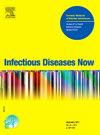Antibiotic susceptibility according to age of clinical strains from hospital respiratory samples: A nationwide study
IF 2.2
4区 医学
Q2 INFECTIOUS DISEASES
引用次数: 0
Abstract
Objectives
This study evaluated the microbiological distribution and sensitivity of clinical strains from respiratory samples of inpatients to the antibiotics usually recommended for treatment of lower respiratory tract infection (LRTI).
Methods
Using the French SPARES (Surveillance et Prévention de l’AntibioRésistance en Etablissement de Santé) database, we recorded all respiratory microbiological samples collected in 2022 in 409 hospitals located in all regions of France. The distribution of main bacterial species and their resistance to the most frequently prescribed antibiotics for LRTI were compared by age group (18–64 years, 65–79 years, ≥ 80 years).
Results
Among 48,721 strains, 47.7 % were isolated from patients aged 18–64 years, 37.9 % aged 65–79 years, and 14.4 % aged ≥ 80 years. Enterobacteriaceae (30.1 %, 36.0 % and 35.1 %, respectively) and Pseudomonas aeruginosa (19.0 %, 25.0 % and 27.1 %) were the most prevalent pathogens, especially in older patients. Conversely, Haemophilus influenzae (14.5 %, 10.7 % and 8.7 %) and Streptococcus pneumoniae (8.3 %, 5.6 % and 3.4 %) were rare in older age. Overall antibiotic resistance increased with age across all classes: in increasing order of resistance, levofloxacin (9.2 %, 11.1 % and 13.2 %), piperacillin-tazobactam (14.5 %, 16.8 % and 17.4 %), cefotaxime (27.4 %, 34.3 % and 39.5 %), doxycycline (28.2 %, 37.4 % and 39.5 %), cotrimoxazole (32.1 %, 38.5 % and 40.2 %), and amoxicillin-clavulanate (37.2 %, 46.0 % and 51.4 %, p < 0.05 for all comparisons). More than half of the strains were resistant to amoxicillin and erythromycin.
Conclusions
In this large nationwide database of respiratory samples, older age was associated with a high prevalence of Enterobacteriaceae and P. aeruginosa and beta-lactam resistance, a finding challenging current LRTI probabilistic treatment. Conversely, H. influenzae and S. pneumoniae were rarely observed in patients over 80 years of age.
医院呼吸道样本临床菌株年龄对抗生素敏感性的影响:一项全国性研究
目的探讨住院患者呼吸道样本微生物学分布及对常用下呼吸道感染(LRTI)抗生素的敏感性。方法利用法国SPARES (Surveillance et prevention de l’antibio或健康状况监测与预防系统)数据库,对法国所有地区409家医院于2022年采集的所有呼吸道微生物样本进行记录。比较各年龄组(18-64岁、65-79岁、≥80岁)LRTI主要菌种分布及对常用抗生素的耐药性。结果48721株分离株中,18 ~ 64岁占47.7%,65 ~ 79岁占37.9%,≥80岁占14.4%。肠杆菌科(分别为30.1%、36.0%和35.1%)和铜绿假单胞菌(分别为19.0%、25.0%和27.1%)是最常见的致病菌,尤其是在老年患者中。相反,流感嗜血杆菌(14.5%,10.7%和8.7%)和肺炎链球菌(8.3%,5.6%和3.4%)在老年人中很少见。总体耐药率随年龄增长呈上升趋势,耐药率依次为左氧氟沙星(9.2%、11.1%、13.2%)、哌拉西林-他唑巴坦(14.5%、16.8%、17.4%)、头孢噻肟(27.4%、34.3%、39.5%)、多西环素(28.2%、37.4%、39.5%)、复方新诺明(32.1%、38.5%、40.2%)、阿莫西林-克拉维酸酯(37.2%、46.0%、51.4%),p <;0.05为所有比较)。半数以上的菌株对阿莫西林和红霉素具有耐药性。结论在这个庞大的全国呼吸样本数据库中,年龄越大,肠杆菌科和铜绿假单胞菌的患病率越高,β -内酰胺耐药性也越高,这一发现对目前的LRTI概率治疗提出了挑战。相反,在80岁以上的患者中很少观察到流感嗜血杆菌和肺炎链球菌。
本文章由计算机程序翻译,如有差异,请以英文原文为准。
求助全文
约1分钟内获得全文
求助全文
来源期刊

Infectious diseases now
Medicine-Infectious Diseases
CiteScore
7.10
自引率
2.90%
发文量
116
审稿时长
40 days
 求助内容:
求助内容: 应助结果提醒方式:
应助结果提醒方式:


